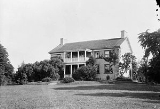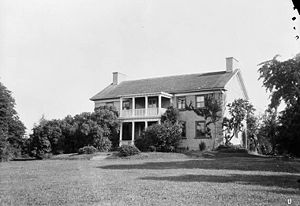
DeCou House
Encyclopedia
DeCew House was built by John DeCew
, c.1808, in Thorold Township
, Upper Canada
. The two story house had limestone walls 66 centimetres (26 in) thick.
 DeCew was a captain in the 2nd Lincoln Militia during the War of 1812
DeCew was a captain in the 2nd Lincoln Militia during the War of 1812
, and also spent almost a year as a prisoner of war
. During his absence, his house was used by the British
army as a detachment headquarters under the command of Lieutenant James FitzGibbon
. The house is remembered as the destination of Laura Secord
's celebrated journey to warn the British of a planned American attack. Thanks to her warning, FitzGibbon was prepared for the attack, and in the ensuing Battle of Beaver Dams
was able to secure the surrender of an American force of approximately 500 men.
Following the war, DeCew lived in the house with his wife Katharine, raising eleven children and operating a mill a short distance away. He sold the house when he relocated to Haldimand County in 1834. The house was purchased by David Griffiths, and he and his descendants occupied the house until 1942. At that time, the property was acquired by the Hydro-Electric Power Commission of Ontario (a predecessor of Ontario Power Generation
). Most of the surrounding land was flooded to create Lake Gibson
as a reservoir for hydroelectric power generation purposes. The house, being on high land, was not flooded and continued to stand unoccupied. In 1950, it was destroyed by fire under suspicious circumstances.
Due to the historical significance of the structure, the lower part of the stone walls were preserved. The Power Commission installed a flagstone floor and a plaque explaining the history of the structure.
In January, 2008, John Burtniak, chair of Thorold's War of 1812 bicentennial committee, urged the City of Thorold to acquire the property to assure the protection of this important historical asset. However, Thorold Council rejected the proposal citing the cost of upkeep. Despite this, the City of Thorold assumed ownership of the DeCou House in early 2011 from the Ontario Power Generation for a nominal fee, completing a restoration project in October of that year.
John DeCew
John DeCew was a United Empire Loyalist, an early settler in the Niagara Peninsula of Upper Canada, a commissioned militia officer in the War of 1812, and a founding member of the Welland Canal Company.- Early life :DeCew was born in 1766 in the British colonies which would, after the...
, c.1808, in Thorold Township
Thorold, Ontario
Thorold is a city in Ontario, Canada, located on the Niagara Escarpment. It is also the seat of the Regional Municipality of Niagara....
, Upper Canada
Upper Canada
The Province of Upper Canada was a political division in British Canada established in 1791 by the British Empire to govern the central third of the lands in British North America and to accommodate Loyalist refugees from the United States of America after the American Revolution...
. The two story house had limestone walls 66 centimetres (26 in) thick.

War of 1812
The War of 1812 was a military conflict fought between the forces of the United States of America and those of the British Empire. The Americans declared war in 1812 for several reasons, including trade restrictions because of Britain's ongoing war with France, impressment of American merchant...
, and also spent almost a year as a prisoner of war
Prisoner of war
A prisoner of war or enemy prisoner of war is a person, whether civilian or combatant, who is held in custody by an enemy power during or immediately after an armed conflict...
. During his absence, his house was used by the British
United Kingdom of Great Britain and Ireland
The United Kingdom of Great Britain and Ireland was the formal name of the United Kingdom during the period when what is now the Republic of Ireland formed a part of it....
army as a detachment headquarters under the command of Lieutenant James FitzGibbon
James FitzGibbon
James FitzGibbon was a British soldier and hero of the War of 1812.Born to Garrett FitzGibbon and Mary Widenham in Glin, County Limerick, Ireland, he enlisted in the Knight of Glin's Yeomanry Corps at age 15...
. The house is remembered as the destination of Laura Secord
Laura Secord
Laura Ingersoll Secord was a Canadian heroine of the War of 1812. She is known for warning British forces of an impending American attack that led to the British victory at the Battle of Beaver Dams.-Early life:...
's celebrated journey to warn the British of a planned American attack. Thanks to her warning, FitzGibbon was prepared for the attack, and in the ensuing Battle of Beaver Dams
Battle of Beaver Dams
The Battle of Beaver Dams took place on 24 June 1813, during the War of 1812. An American column marched from Fort George and attempted to surprise a British outpost at Beaver Dams, billeting themselves overnight in the village of Queenston, Ontario...
was able to secure the surrender of an American force of approximately 500 men.
Following the war, DeCew lived in the house with his wife Katharine, raising eleven children and operating a mill a short distance away. He sold the house when he relocated to Haldimand County in 1834. The house was purchased by David Griffiths, and he and his descendants occupied the house until 1942. At that time, the property was acquired by the Hydro-Electric Power Commission of Ontario (a predecessor of Ontario Power Generation
Ontario Power Generation
Ontario Power Generation is a public company wholly owned by the Government of Ontario. OPG is responsible for approximately 70% of the electricity generation in the Province of Ontario, Canada. Sources of electricity include nuclear, hydroelectric, solar, wind, and fossil fuel...
). Most of the surrounding land was flooded to create Lake Gibson
Lake Gibson
Lake Gibson is a lake near Thorold, Ontario, Canada. The lake is not natural, but rather was created as a reservoir for hydroelectric power generation at the Ontario Power Generation Decew Falls 1 and Decew Falls 2 generating stations. The lake was created by flooding the shallow valley of...
as a reservoir for hydroelectric power generation purposes. The house, being on high land, was not flooded and continued to stand unoccupied. In 1950, it was destroyed by fire under suspicious circumstances.
Due to the historical significance of the structure, the lower part of the stone walls were preserved. The Power Commission installed a flagstone floor and a plaque explaining the history of the structure.
In January, 2008, John Burtniak, chair of Thorold's War of 1812 bicentennial committee, urged the City of Thorold to acquire the property to assure the protection of this important historical asset. However, Thorold Council rejected the proposal citing the cost of upkeep. Despite this, the City of Thorold assumed ownership of the DeCou House in early 2011 from the Ontario Power Generation for a nominal fee, completing a restoration project in October of that year.

